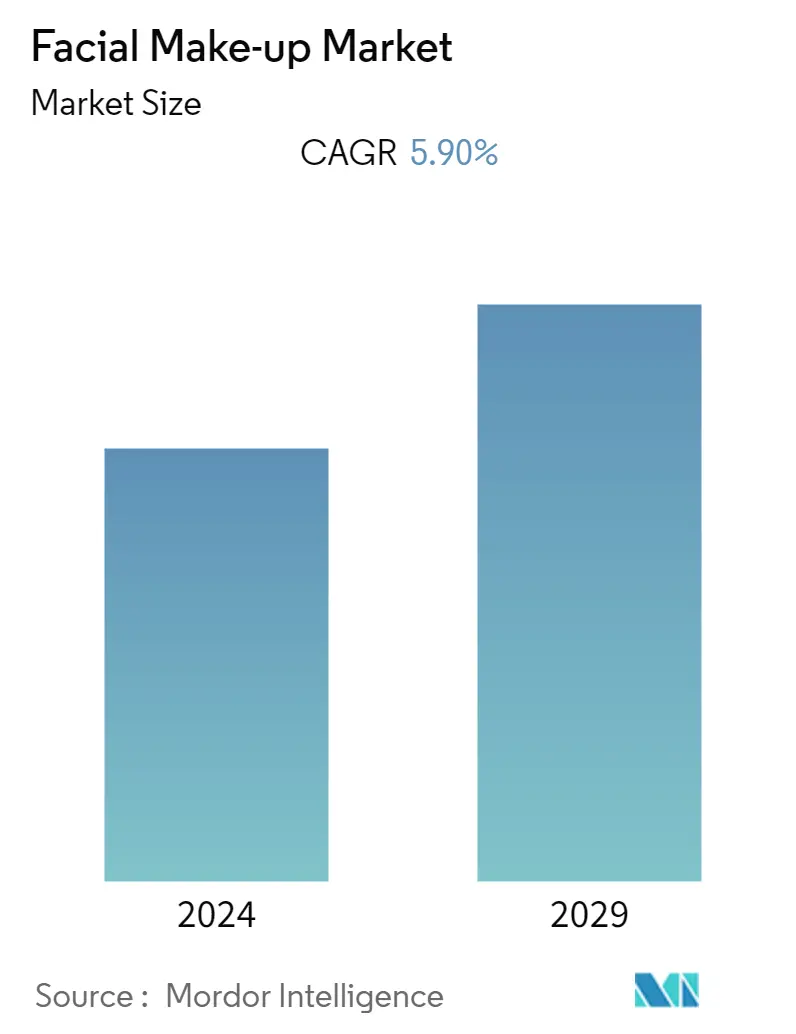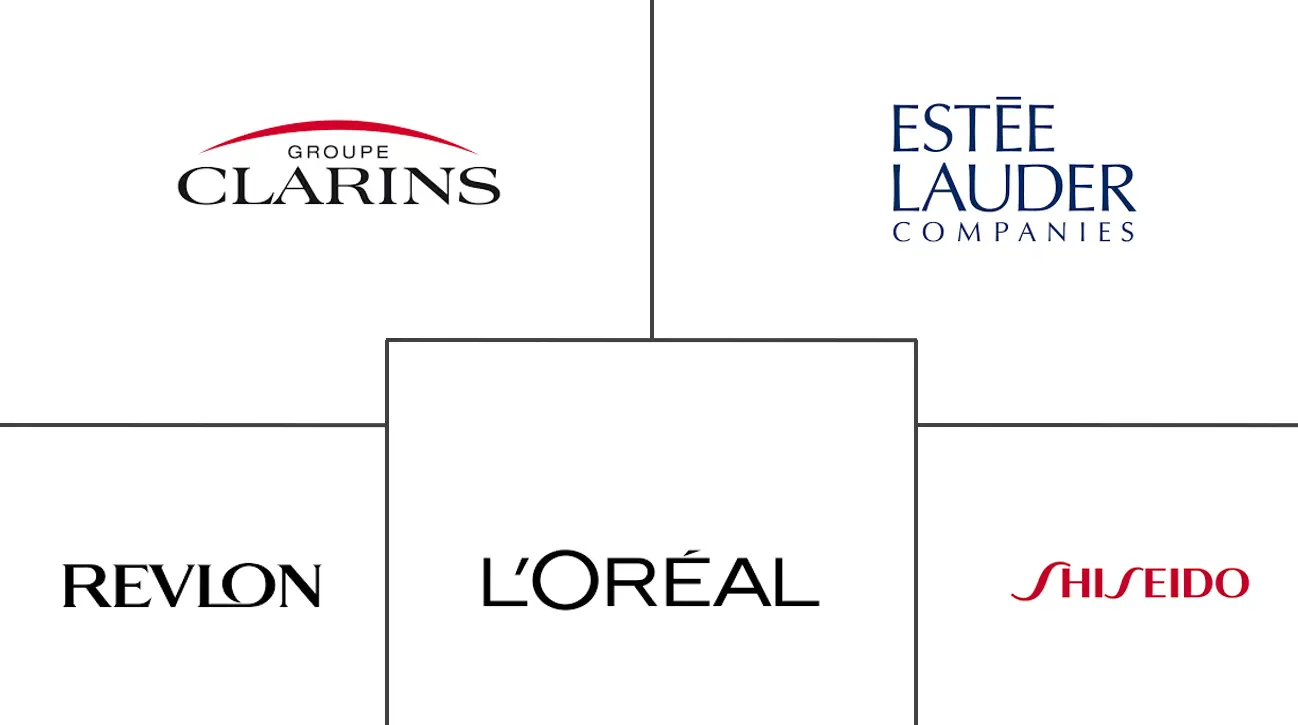Market Size of Facial Make-up Industry

| Study Period | 2019 - 2029 |
| Base Year For Estimation | 2023 |
| CAGR | 5.90 % |
| Fastest Growing Market | Asia Pacific |
| Largest Market | North America |
| Market Concentration | Low |
Major Players
*Disclaimer: Major Players sorted in no particular order |
Facial Makeup Market Analysis
The facial make-up market is projected to register a CAGR of 5.9% during the forecast period, 2022-2027.
The COVID-19 pandemic has influenced consumers' spending habits, leading to a decline in the market growth in 2020, owing to various government restrictions and multiple measures intended to decrease the spread of COVID-19. This reduced the sales of facial make-up products as they do not come under necessary goods and services. Due to the stay-at-home or work-from-home trends, customers were not engaging in social gatherings, which led to a decrease in or no usage of facial make-up products. However, with the availability of products over various e-commerce shopping websites with an easy home delivery option in developing countries, sales have been steadily increasing.
The increasing number of working women and rising consciousness about physical appearance among millennial women across the world are key growth drivers of the facial make-up market. The increasing demand for natural and organic cosmetics is resulting in a growing demand for cosmetic products with natural plant-based ingredients and clean-label packaging, which is boosting the sales of facial make-up products globally.
However, stringent regulations imposed on the usage of cosmetic ingredients by government agencies such as the Food Drug Administration (FDA) and the European Union are major constraints for market development. Usage of harmful chemicals in facial make-up products may lead to allergic reactions, thereby hampering the growth of the market.
Facial Makeup Industry Segmentation
Facial make-up products are products used to color and highlight facial features. The facial make-up market is segmented by type (face powder, facial foundation, facial concealer, face bronzer, blush, and other types), distribution channel (supermarkets/hypermarkets, convenience stores, specialty stores, online retail stores, and other distribution channels), and geography (North America, Europe, Asia-Pacific, South America, and Middle-East and Africa). The report offers the market size and forecasts in value (USD million) for the above segments.
| Type | |
| Face Powder | |
| Facial Foundation | |
| Facial Concealer | |
| Face Bronzer | |
| Blush | |
| Other Types |
| Distribution Channel | |
| Hypermarkets/Supermarkets | |
| Convenience Stores | |
| Specialty Stores | |
| Online Retail Stores | |
| Other Distribution Channels |
| Geography | |||||||||
| |||||||||
| |||||||||
| |||||||||
| |||||||||
|
Facial Make-up Market Size Summary
The facial makeup market is experiencing a resurgence after the initial decline caused by the COVID-19 pandemic, which altered consumer spending habits and reduced demand due to social distancing measures. The market is now benefiting from the rise of e-commerce, particularly in developing regions, where easy home delivery options have facilitated increased sales. Key drivers of growth include the rising number of working women and a growing awareness among millennial women about personal appearance. This has led to a heightened demand for natural and organic cosmetics, as consumers increasingly prefer products with plant-based ingredients and clean-label packaging. However, the market faces challenges from stringent regulations on cosmetic ingredients and concerns over the use of harmful chemicals, which can lead to allergic reactions and hinder market expansion.
North America holds the largest market share, with the United States leading due to changing consumer lifestyles and a growing preference for organic products, fueled by digital media and social media influence. The competitive landscape is marked by the presence of major players like L'Oreal SA, Revlon, and The Estée Lauder Companies Inc., who are focusing on product innovation, expansions, and strategic mergers and acquisitions to meet evolving consumer demands. Companies are leveraging advanced distribution networks and digital marketing to enhance product visibility and reach. The market's growth is further supported by the introduction of vegan and clean-label products, as seen in Coty Inc.'s relaunch of Kyle Cosmetics and the expansion of the Gucci beauty line, catering to the increasing consumer preference for organic and natural products.
Facial Make-up Market Size - Table of Contents
-
1. MARKET DYNAMICS
-
1.1 Market Drivers
-
1.2 Market Restraints
-
1.3 Porter's Five Forces Analysis
-
1.3.1 Threat of New Entrants
-
1.3.2 Bargaining Power of Buyers/Consumers
-
1.3.3 Bargaining Power of Suppliers
-
1.3.4 Threat of Substitute Products
-
1.3.5 Intensity of Competitive Rivalry
-
-
-
2. MARKET SEGMENTATION
-
2.1 Type
-
2.1.1 Face Powder
-
2.1.2 Facial Foundation
-
2.1.3 Facial Concealer
-
2.1.4 Face Bronzer
-
2.1.5 Blush
-
2.1.6 Other Types
-
-
2.2 Distribution Channel
-
2.2.1 Hypermarkets/Supermarkets
-
2.2.2 Convenience Stores
-
2.2.3 Specialty Stores
-
2.2.4 Online Retail Stores
-
2.2.5 Other Distribution Channels
-
-
2.3 Geography
-
2.3.1 North America
-
2.3.1.1 United States
-
2.3.1.2 Canada
-
2.3.1.3 Mexico
-
2.3.1.4 Rest of North America
-
-
2.3.2 Europe
-
2.3.2.1 United Kingdom
-
2.3.2.2 Germany
-
2.3.2.3 Spain
-
2.3.2.4 France
-
2.3.2.5 Italy
-
2.3.2.6 Russia
-
2.3.2.7 Rest of Europe
-
-
2.3.3 Asia-Pacific
-
2.3.3.1 China
-
2.3.3.2 Japan
-
2.3.3.3 India
-
2.3.3.4 Australia
-
2.3.3.5 Rest of Asia-Pacific
-
-
2.3.4 South America
-
2.3.4.1 Brazil
-
2.3.4.2 Argentina
-
2.3.4.3 Rest of South America
-
-
2.3.5 Middle-East and Africa
-
2.3.5.1 United Arab Emirates
-
2.3.5.2 South Africa
-
2.3.5.3 Rest of Middle-East and Africa
-
-
-
Facial Make-up Market Size FAQs
What is the current Facial Make-up Market size?
The Facial Make-up Market is projected to register a CAGR of 5.90% during the forecast period (2024-2029)
Who are the key players in Facial Make-up Market?
L’Oreal S.A., Revlon, The Estée Lauder Companies Inc., Shiseido Co., Ltd. and Clarins Group are the major companies operating in the Facial Make-up Market.

